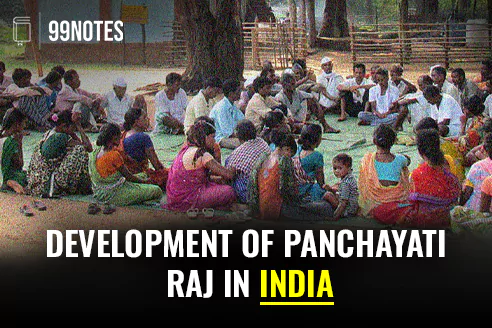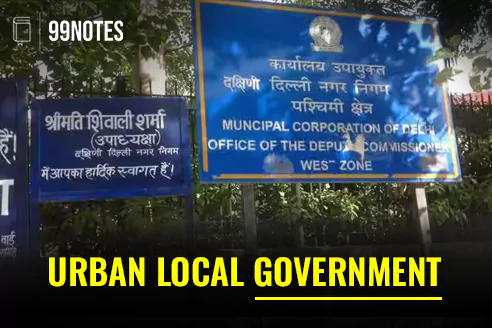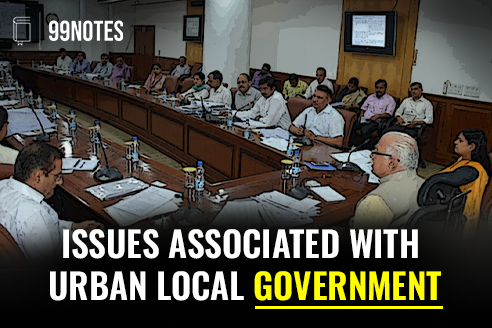
Local Government

1. Panchayati Raj in India
In 1992, one of the biggest changes in the Indian constitutional scheme was introduced. It introduced a third teir of Government in India in the form of Panchayats and Urban Local bodies through 73rd and 74th Constitutional amendment respectively. In this chapter we shall study the local government in Rural areas of India, viz. the Panchayati Raj system.

2. Development of Panchayati Raj in India
Panchayati Raj is an insignificant provision of the Gandhian principle. However, the constitution did not obligate governments to constitute panchayats. Article 40 of the Indian Constitution only provided a Directive Principle of State Policy that said the state should organise village panchayats and give them the necessary powers and authority to function.

3. Urban Local Government
The Representation of People Act of 1951 provides for the conduct of elections in India. It defines the roles and responsibilities of government officials and the procedures for the conduct of elections, such as on the matters of nomination, campaigning, polling, counting, declaration of results and offences.

4. Types of urban local government
The Government of India Act 1935 brought local government within the purview of the provincial government and granted them enhanced powers. Since that time, local government evolved a lot. Currently, eight types of urban local bodies are visible in India.

5. Issues associated with Urban Local Government
Urban governance and management have predominantly been the constitutional domain of state government. These local institutions of urban government have become weak over the years due to many factors, including encroachment on traditional and legitimate municipal functions by creating parastatals and urban development authorities.
Local Government in India
Local Government refer to all such sets of governmental organisations and bodies that look after the administration of an area or small community such as villages, towns, or cities.
In India, such institutions are generally referred to as the institutions of self-governance due to the presence of a social audit mechanism via the means of Panchayats. Therefore, these are also referred to as the Panchayati Raj institutions.
Importance of Local Government in the UPSC Exam
While reading the articles given on this page you will realise why studying these local bodies is important. But how is it important from the UPSC CSE point of view?
In the UPSC Civil Service examination each year at least one question is asked from the Local bodies in the UPSC Mains Examination, referring to the federal system of India. Similarly, 1-2 questions on average are asked in the UPSC Prelims exam.
Further, it is necessary to understand the structure of our local bodies in order to understand the intricacies of Governance in India and Ethics in GS4.
More about Local Government
In the Indian political system, the administration is composed of three tiers of the government, which consists of: The Union Executive (Central Government), the State Executive (state Government) the Panchayati Raj Institutions and Urban Local bodies (Local Government).
At the local level too, the government is divided into several levels to ensure effective public participation. The following diagram explains the structure of the government at the local level in India.

From the above chart, one must note that the structure of Local bodies in an area depends on the population and level of urbanisation of the area. In the Rural areas, Elections are held at the ward level where members are elected. These members form the Block Panchayat at the Block level and a certain number of elected members form the District Panchayat at the district level.
In the Urban areas, Nagar Panchayat, Nagar Palika and Mahanagar Palika are the main organs of the urban local government.
How many elected members are there in India’s Panchayati Raj system?
Collectively, the more than 30 Lakh elected people form part of India’s Panchayati Raj system. It makes India with the largest number of elected members in any democracy around the world.
Why UPSC asks questions on Urban Local Government
Local bodies are an important topic for the UPSC Civil Services Exam (CSE) because the practical aspects of governance are intricately linked with the local government structures in India. From Swachh Bharat Abhiyan to MGNREGA, from Jal Shakti Mission to PM Awas Yojana, all are implemented using these structures. UPSC realises this and therefore, it asks such questions which require a civil services aspirant to know about the structure of local bodies/governments in India.
The UPSC CSE is a competitive examination that tests candidates on their knowledge of a wide range of topics, including Indian history, geography, economics, and current affairs. The functioning of the Local bodies and the role of the Panchayati Raj Institutions in the governance of the country are important aspects of the exam syllabus.
In the UPSC CSE, questions on the Panchayati Raj institutions and Urban Local bodies may be asked in the general studies paper in the Prelims and the Mains exam as well as in the Personality test. It is therefore important for candidates to have a good understanding of local bodies.

